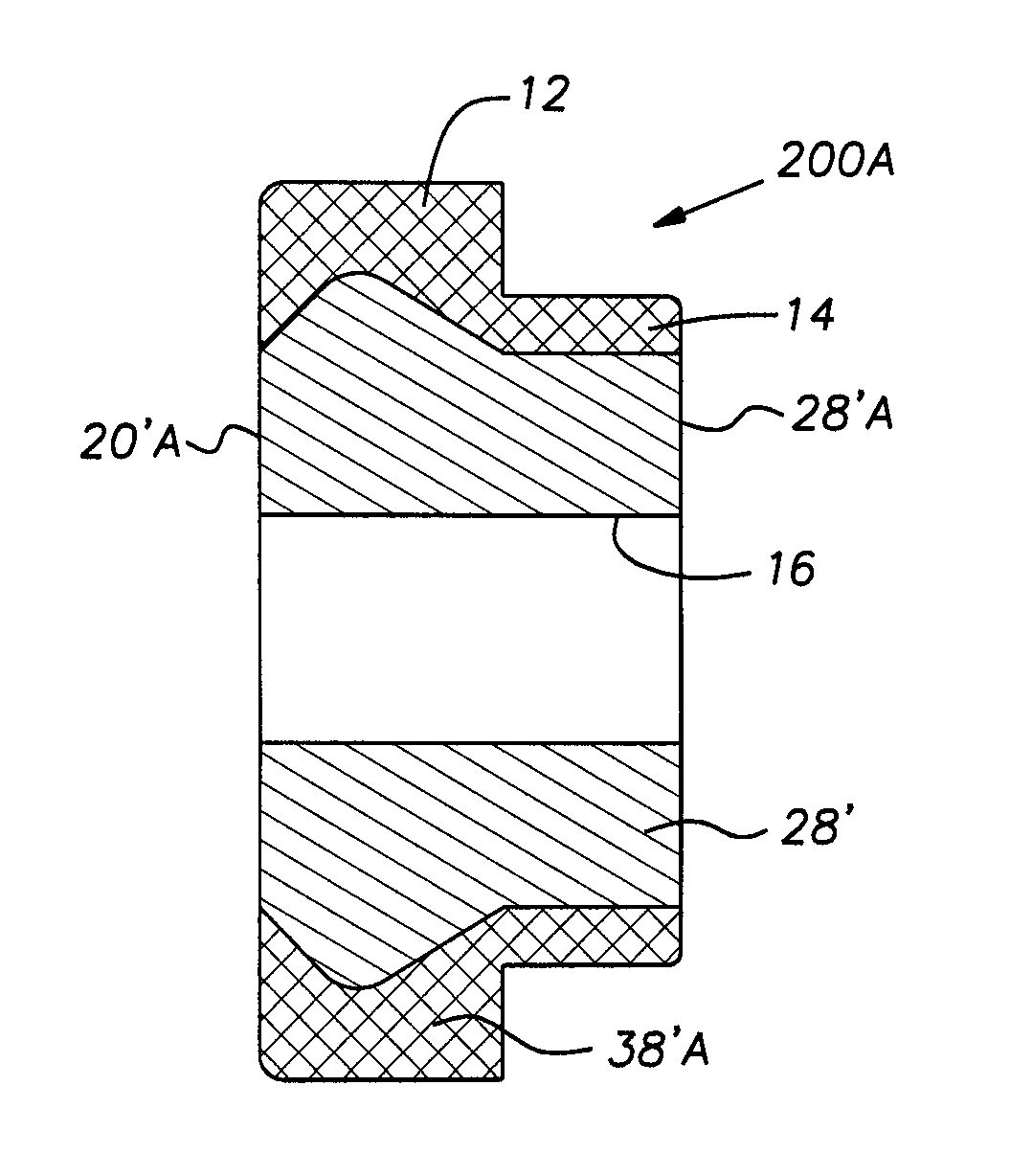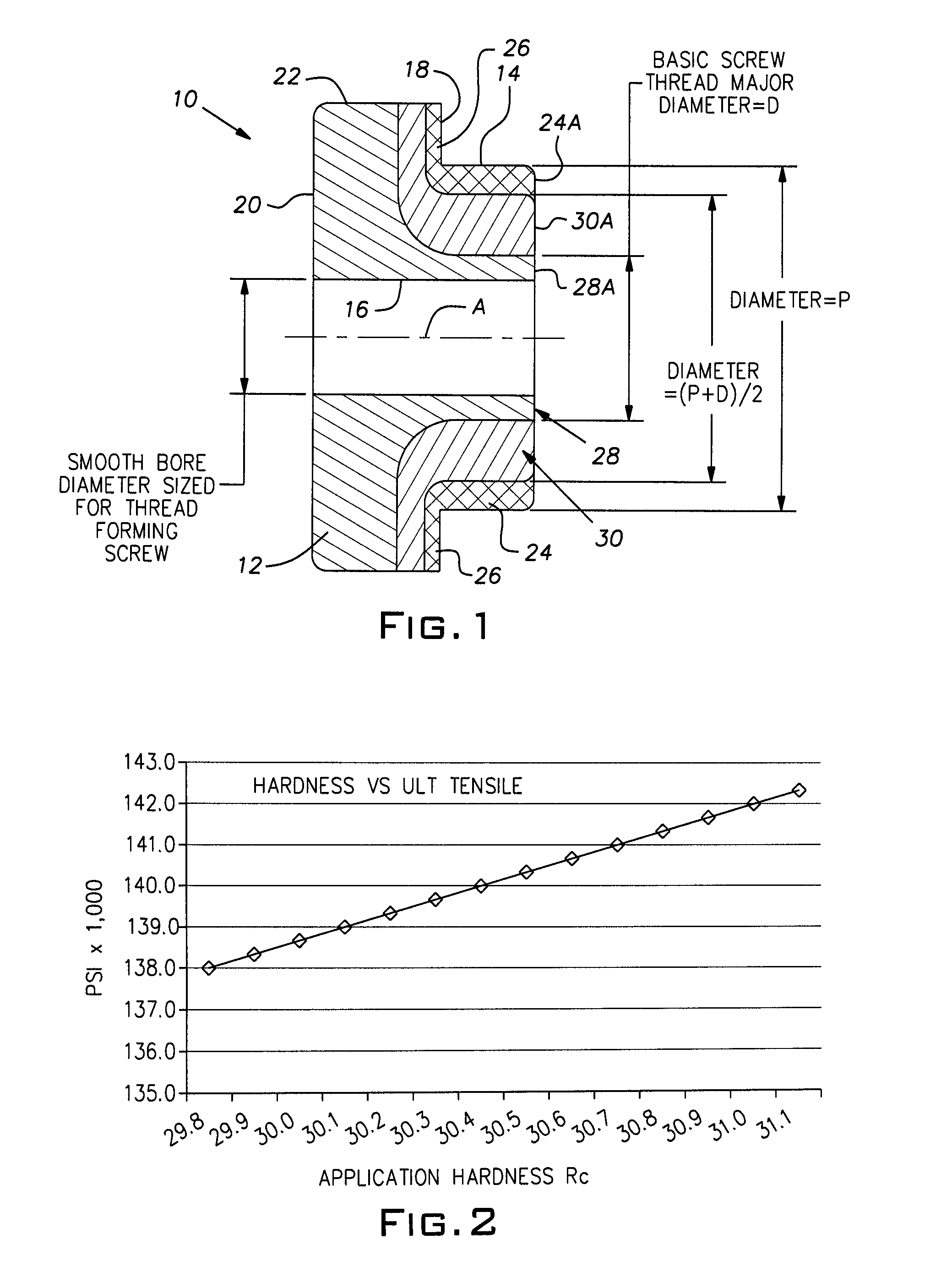Clinch nut
a clinch nut and nut technology, applied in the field of self-attaching fasteners, can solve the problems of unsatisfactory or competitive, unwanted deformation or distortion of the fastener, and the hardness and strength of the clinch nut may not be simply increased to solve the foregoing problems, and achieves greater piercing and/or setting forces, increased strength of metal members, and enhanced fastener resistance
- Summary
- Abstract
- Description
- Claims
- Application Information
AI Technical Summary
Benefits of technology
Problems solved by technology
Method used
Image
Examples
first embodiment
[0053]The self-piercing clinch nut 10′ has a body portion 12′ and a pilot or punch portion 14′ extending from one end of the body portion 12′. A thread blank or bore 16 extends along the longitudinal axis A of the nut 10′. As in the first embodiment, the body portion 12′ includes an annular mounting or bottom end face 18′, an annular top end face 20′ and a peripheral body face 22′ that joins the end face 18′ and the top face 20′.
[0054]In this embodiment, the annular top end face 20′ is also selectively hardened to provide a top zone 32 remote of the inner zone 28′. The top zone 32 has an annular shape extending transversely or radially outwardly along the end face 20′ from an annular top end face 20′A corresponding with the thread major diameter to the outer peripheral body face 22′.
[0055]The top zone 32 has a hardness corresponding with that of the outer zone 24′. The increased hardness of the top zone further resists crushing and / or plastic deformation of the metal forming the top...
second embodiment
[0062]As described in connection with the second embodiment, the nut 10″ may also be provided with a top zone 32 in its top face 20′. A peripheral zone 34 extends along the peripheral body face 22′. Again, the top zone 32 may extend to the dotted line 36 to form the enlarged peripheral zone 38 to substantially encase the nut 10″ in joined and continuous zones of increased metal hardness.
[0063]Clinch nuts having various pilot shapes, annular face arrangements and lugs are also illustrated in Design applications Nos. D440,865S, D448,659S and D448,660S. Selected figures from these design cases are included herein and briefly discussed below.
[0064]Referring to FIGS. 8 through 10, a nut 40 is shown. The nut 40 includes a body portion 42, a pilot portion 44 and a screw thread 46 extending along a central axis.
[0065]The nut 40 includes a mounting or bottom end face 48, an annular top end face 50 and a peripheral body face 52 joining the bottom and top faces. A generally annular shaped groo...
PUM
| Property | Measurement | Unit |
|---|---|---|
| ultimate tensile strength | aaaaa | aaaaa |
| ultimate tensile strength | aaaaa | aaaaa |
| ultimate tensile strength | aaaaa | aaaaa |
Abstract
Description
Claims
Application Information
 Login to View More
Login to View More - R&D
- Intellectual Property
- Life Sciences
- Materials
- Tech Scout
- Unparalleled Data Quality
- Higher Quality Content
- 60% Fewer Hallucinations
Browse by: Latest US Patents, China's latest patents, Technical Efficacy Thesaurus, Application Domain, Technology Topic, Popular Technical Reports.
© 2025 PatSnap. All rights reserved.Legal|Privacy policy|Modern Slavery Act Transparency Statement|Sitemap|About US| Contact US: help@patsnap.com



